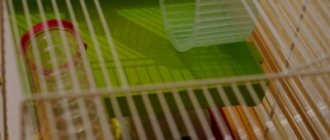Many first-time hamster owners prefer to keep them in a jar. But a terrarium or an indoor aquarium is more convenient for both the pet and its owner. These structures not only satisfy all the requirements of hygiene and comfort for rodents, but also muffle the rustling noise at night.
We will learn how to build an aquarium and terrarium for a hamster with your own hands, and also analyze all the pros and cons of these structures.
A jar instead of a cage
Usually, loving owners buy a beautiful and spacious cage for a furry pet. But there are also individuals who put a tiny creature in a jar and think that the hamster is comfortable there. But under no circumstances should you keep your hamster in a jar for the rest of its life! In such conditions, the pet will not last long; you can be sure that he will get sick and die.
Related article: Is it possible to keep a hamster in the same cage with a guinea pig, rat, rabbit or degu?
Compared to a cage, a jar does not have a single advantage, but there are more than enough disadvantages:
- very little space. Home will be cramped even in a three-liter jar, the animal will have nowhere to run.
- The hamster furniture will not fit into the jar. The only thing you can fit into it is a house or a feeder with food;
- There is nowhere to attach a hanging drinker. Firstly, there is no grate from which it is convenient to hang the sippy cup, and secondly, all the free space has already been occupied by the feeder;
- there will be nothing to breathe in the jar, because air will only enter through the neck;
- fumes from feces and urine, primarily poisonous ammonia, will remain inside the glass prison, because the air in such a structure does not circulate at all. You will have to change the bedding and wash the jar well 2-3 times a day, otherwise the fluffy will simply die from suffocation;
- lack of air circulation will provoke increased proliferation of pathogenic microorganisms, and your pet will be susceptible to infectious diseases;
- bank - the house is very unstable. It is easy to accidentally knock it over or sweep it off the table. By the way, a Syrian hamster is quite strong enough to knock over a jar on its own;
- if there is also a cat living in the apartment, then she will quickly get the fluffy one in this precarious apartment.
Lack of space for movement and lack of air can quickly kill a small animal. Therefore, it is allowed to keep a hamster in a jar for no more than half an hour, that is, while cleaning its cage.
An alternative to a jar during sanitary work can be a cardboard box or a plastic 5-liter bottle with slots.
Keeping rodents in aquariums
Aquariums and terrariums are much better for hamsters than a small glass jar. Firstly, they are stable, and secondly, they have much more space. But is it possible to keep a hamster in an aquarium permanently?
Article on the topic: A toilet for a hamster: how to equip and train your pet, how to make it yourself
In principle, this is not prohibited. But a hamster terrarium must meet the following requirements:
- Big square. For representatives of the Syrian breed, the optimal dimensions are 50 x 100 cm, but for the Djungarian breed this is just a palace!
- Low height. The optimal height of the walls is 30 cm. This way, air exchange will occur freely, and the second tier can be installed. The maximum height is 40 cm. If you make the roof higher, then fresh air will not reach the fluffy in sufficient quantities.
- Additional ventilation slots. In order for air to circulate better in the hamster’s apartment, additional slits will have to be cut in the walls. This is quite difficult to do. In addition, the homa should not reach them. If you do not know how to cut glass, then a terrarium for a hamster should be a temporary option, but not a permanent home.
- Lattice ceiling.
It is also worth noting that each homa should have its own separate aquarium.
Advantages and disadvantages of aquariums
Compared to a cramped jar, an aquarium for a hamster is a winning option. But if you compare it with a cage, you can identify a number of pros and cons. Let's look at them in more detail.
Let's start with the disadvantages:
- air circulation in glass terrariums is poorer;
- the hamster is constantly surrounded by the smell of its own feces;
- in conditions of reduced air circulation, bacteria multiply faster;
- the terrarium will have to be cleaned 2 times more often than the cage so that the animal does not get sick;
- It will be more difficult to install a hanging drinking bowl for an animal in an aquarium;
- glass and fiberglass are quite cold materials: a very thick layer of filler is required so that the animal’s paws and tummy do not freeze.
Of course, these disadvantages are quite serious, but glass houses also have their advantages.
- Khoma will not be able to chew through the glass and escape;
- Fluffy will not be affected by drafts, even if the window is open in the room with the terrarium;
- the unpleasant smell will not spread throughout the room;
- there will be much less noise, which will give you the opportunity to sleep peacefully at night without taking the hamster palace out of the room;
- the filler will not spill out, and the fluffy himself will not be able to throw pieces of food and poop through the walls, as a result - cleanliness and order around the cage;
- Through the transparent glass it is very convenient to observe the animal and arrange photo sessions (of course, without flash), the rods will not fit into the frame.
Article on the topic: How to make a hamster cage with your own hands at home from scrap materials
That is, the aquarium also has many advantages. But what will tip the scales? Think about it: all the shortcomings only harm the hamster; they do not affect the owners in any way. Now analyze the advantages. A person benefits a lot from them, but what about a hamster?
In fact, it doesn’t matter to a home whether the room smells delicious or whether there is bedding lying around his cage. Only the owners worry about this. That is, those who choose a glass terrarium as a place to live for a hamster think first of all about themselves, and not about the comfort of the pet. Remember: it is much better to keep your furry friend in a wire cage or mesh cage!
Aquarium, terrarium, jar for a hamster: is it possible to keep a rodent in them?
Most often, small rodents are placed in cages; much less often, owners provide an aquarium for a hamster. Even less often, glass jars are used as apartments for hamsters. Are these tanks suitable for keeping a little friend? What are their advantages and disadvantages compared to a regular cell? You will get answers to these questions in this article.
A jar instead of a cage
Usually, loving owners buy a beautiful and spacious cage for a furry pet. But there are also individuals who put a tiny creature in a jar and think that the hamster is comfortable there. But under no circumstances should you keep your hamster in a jar for the rest of its life! In such conditions, the pet will not last long; you can be sure that he will get sick and die.
Compared to a cage, a jar does not have a single advantage, but there are more than enough disadvantages:
- very little space. Home will be cramped even in a three-liter jar, the animal will have nowhere to run.
- The hamster furniture will not fit into the jar. The only thing you can fit into it is a house or a feeder with food;
- There is nowhere to attach a hanging drinker. Firstly, there is no grate from which it is convenient to hang the sippy cup, and secondly, all the free space has already been occupied by the feeder;
- there will be nothing to breathe in the jar, because air will only enter through the neck;
- fumes from feces and urine, primarily poisonous ammonia, will remain inside the glass prison, because the air in such a structure does not circulate at all. You will have to change the bedding and wash the jar well 2-3 times a day, otherwise the fluffy will simply die from suffocation;
- lack of air circulation will provoke increased proliferation of pathogenic microorganisms, and your pet will be susceptible to infectious diseases;
- bank - the house is very unstable. It is easy to accidentally knock it over or sweep it off the table. By the way, a Syrian hamster is quite strong enough to knock over a jar on its own;
- if there is also a cat living in the apartment, then she will quickly get the fluffy one in this precarious apartment.
Lack of space for movement and lack of air can quickly kill a small animal. Therefore, it is allowed to keep a hamster in a jar for no more than half an hour, that is, while cleaning its cage.
An alternative to a jar during sanitary work can be a cardboard box or a plastic 5-liter bottle with slots.
rodents in aquariums
Aquariums and terrariums are much better for hamsters than a small glass jar. Firstly, they are stable, and secondly, they have much more space. But is it possible to keep a hamster in an aquarium permanently?
In principle, this is not prohibited. But a hamster terrarium must meet the following requirements:
- Big square. For representatives of the Syrian breed, the optimal dimensions are 50 x 100 cm, but for the Djungarian breed this is just a palace!
- Low height. The optimal height of the walls is 30 cm. This way, air exchange will occur freely, and the second tier can be installed. The maximum height is 40 cm. If you make the roof higher, then fresh air will not reach the fluffy in sufficient quantities.
- Additional ventilation slots. In order for air to circulate better in the hamster’s apartment, additional slits will have to be cut in the walls. This is quite difficult to do. In addition, the homa should not reach them. If you do not know how to cut glass, then a terrarium for a hamster should be a temporary option, but not a permanent home.
- Lattice ceiling.
It is also worth noting that each homa should have its own separate aquarium.
Advantages and disadvantages of aquariums
Compared to a cramped jar, an aquarium for a hamster is a winning option. But if you compare it with a cage, you can identify a number of pros and cons. Let's look at them in more detail.
Let's start with the disadvantages:
- air circulation in glass terrariums is poorer;
- the hamster is constantly surrounded by the smell of its own feces;
- in conditions of reduced air circulation, bacteria multiply faster;
- the terrarium will have to be cleaned 2 times more often than the cage so that the animal does not get sick;
- It will be more difficult to install a hanging drinking bowl for an animal in an aquarium;
- glass and fiberglass are quite cold materials: a very thick layer of filler is required so that the animal’s paws and tummy do not freeze.
Of course, these disadvantages are quite serious, but glass houses also have their advantages.
Main advantages:
- Khoma will not be able to chew through the glass and escape;
- Fluffy will not be affected by drafts, even if the window is open in the room with the terrarium;
- the unpleasant smell will not spread throughout the room;
- there will be much less noise, which will give you the opportunity to sleep peacefully at night without taking the hamster palace out of the room;
- the filler will not spill out, and the fluffy himself will not be able to throw pieces of food and poop through the walls, as a result - cleanliness and order around the cage;
- Through the transparent glass it is very convenient to observe the animal and arrange photo sessions (of course, without flash), the rods will not fit into the frame.
That is, the aquarium also has many advantages. But what will tip the scales? Think about it: all the shortcomings only harm the hamster; they do not affect the owners in any way. Now analyze the advantages. A person benefits a lot from them, but what about a hamster?
In fact, it doesn’t matter to a home whether the room smells delicious or whether there is bedding lying around his cage. Only the owners worry about this. That is, those who choose a glass terrarium as a place to live for a hamster think first of all about themselves, and not about the comfort of the pet. Remember: it is much better to keep your furry friend in a wire cage or mesh cage!
Alternative solution
We have already found out that a cage is much better suited for keeping a hamster at home. But if you have a spare aquarium at home, it can also be adapted to suit a hamster’s needs. For example, in a terrarium you can arrange a relaxation and entertainment room for your beloved pet.
Here are the items you can place in the aquarium:
- Running wheel on a stand.
- Various pipes and labyrinths.
- Spacious shelter.
- Toilet (if the animal is accustomed to it).
- Bath with sand for bathing.
- Various stairs and bridges.
The hamster can be moved into the terrarium to play, especially if all the attractions do not fit into the cage. You can also place the animal in the rest room while you tidy up its permanent home.
Don't forget that in addition to toys there should also be essential items. Be sure to leave a bowl of food, saucer or bottle of water for your furry friend.
Sanitary difficulties
We especially highlighted one of the disadvantages of the aquarium. The fact is that a large glass house is extremely difficult to clean. After all, usually the terrarium consists entirely of glass, and is not installed on a glass tray. When washing, it is easy to cut yourself or break the hamster's house.
And you will have to wash it more often than a regular cage with a wire frame. In addition, the lack of free air circulation allows not only dangerous bacteria, but also mold to actively multiply.
It is very difficult to remove it from joints, and sealants cannot provide a 100 percent guarantee that it will not appear.
To disinfect the aquarium as much as possible, you will have to use aggressive agents, and many of them are toxic to hamsters.
A hamster can be kept in wide aquariums, but the animal will be much more comfortable in a cage. A house made of twigs is more consistent with hygienic standards for small rodents. But if you have an empty terrarium, you can easily adapt it into a room with attractions for temporarily keeping a hamster.
Source: https://ohomjakah.ru/soderzhanie/akvarium-terrarium-banka-dlya-homyaka-mozhno-li-v-nih-derzhat-gryzuna
Alternative solution
We have already found out that a cage is much better suited for keeping a hamster at home. But if you have a spare aquarium at home, it can also be adapted to suit a hamster’s needs. For example, in a terrarium you can arrange a relaxation and entertainment room for your beloved pet.
Here are the items you can place in the aquarium:
- Running wheel on a stand.
- Various pipes and labyrinths.
- Spacious shelter.
- Toilet (if the animal is accustomed to it).
- Bath with sand for bathing.
- Various stairs and bridges.
The hamster can be moved into the terrarium to play, especially if all the attractions do not fit into the cage. You can also place the animal in the rest room while you tidy up its permanent home.
Don't forget that in addition to toys there should also be essential items. Be sure to leave a bowl of food, saucer or bottle of water for your furry friend.
Sanitary difficulties
We especially highlighted one of the disadvantages of the aquarium. The fact is that a large glass house is extremely difficult to clean. After all, usually the terrarium consists entirely of glass, and is not installed on a glass tray. When washing, it is easy to cut yourself or break the hamster's house.
Article on the topic: How to make a walking ball for a hamster with your own hands at home
And you will have to wash it more often than a regular cage with a wire frame. In addition, the lack of free air circulation allows not only dangerous bacteria, but also mold to actively multiply. It is very difficult to remove it from joints, and sealants cannot provide a 100 percent guarantee that it will not appear. To disinfect the aquarium as much as possible, you will have to use aggressive agents, and many of them are toxic to hamsters.
A hamster can be kept in wide aquariums, but the animal will be much more comfortable in a cage. A house made of twigs is more consistent with hygienic standards for small rodents. But if you have an empty terrarium, you can easily adapt it into a room with attractions for temporarily keeping a hamster.
Is it possible to keep a hamster in an aquarium and terrarium?
When buying an animal such as a hamster for home, you should first acquire a cage to keep it. Modern pet stores offer several types of designs for dwarf animals. Most often, livestock breeders prefer a cage design. But there are two more options - a terrarium and an aquarium. Could such houses for dwarf rodents become an alternative to a cage house? To what extent does an aquarium and terrarium for a hamster meet the requirements for keeping such a pet? In this article we will tell you about this.
Hamster in an aquarium and terrarium
Terrarium
Despite the fact that the cage design with metal rods for hamsters is very popular and in demand, it also has some disadvantages:
- there is a high risk of the hamster getting outside the home;
- a hamster living in such a cage will constantly scatter bedding outside the cage, etc.
In this case, pet store sellers offer livestock breeders terrariums, the choice of which is very large.
When buying such housing for your hamster, choose a model made of inorganic glass. Plexiglas wears out and fades very quickly. Also, if you plan to keep multiple pets in it, you will need a larger model. This must be taken into account, since rodents staying in close quarters will lead to disastrous consequences.
Article on the topic: Filler for hamsters: which one is better to choose (sawdust, paper and other types of bedding)
Advantages and disadvantages
The advantage of such designs is as follows:
- Accurate calculation of dimensions. When purchasing such a structure, you will not need to take measurements, since in structures of this type all the proportions of the bottom and walls are maintained.
- Almost all models have a ventilation system installed.
- As a rule, all terrariums consist of two parts - a transparent base and a plastic tray.
- In such housing, your hamster will always be visible, and it is very convenient to watch him from all sides.
- The terrarium is very easy to clean.
- This design is ideal for those owners who do not like noise.
This design also has disadvantages, although they are not significant. When installing such a home, the owner needs to think about how to attach the drinking bowl. Although many people use suction cups or place heavy containers on the floor. Then the hamster simply will not be able to turn it over.
Another negative point is that in a terrarium that is made of glass, you will not have the opportunity to pet your furry. But you can easily get it out by opening the lid of the structure.
Aquarium
Hamsters do well in aquariums
Many breeders have doubts about whether it is possible to keep a hamster in an aquarium. All this is due to ignorance. Worried if this will harm your hamster? Believe me, there is no reason to worry!
If you use a structure made by specialists, then rest assured that it contains everything a pet rodent needs for a full life and development. This design is made of glass (organic or regular). The top of the aquarium is covered with a metal or plastic mesh, which prevents the rodent from getting out of the home.
To ensure ventilation, the bottom of the aquarium is drilled in several places at a distance of 10 cm from the floor.
Article on the topic: How to properly arrange a hamster cage, accessories and home decoration for Djungarian and Syrian pets
The glass bottom is covered with felt, sawdust, hay or other material that is sold in pet stores.
The dimensions of the housing should be selected based on the size of the pet. For example, aquariums measuring 100x40 cm are suitable for dwarfs. Syrian rodents will need a larger aquarium. If desired, such a design can be made with your own hands. To do this you will need glass, glass glue and a tool for cutting the material - a jigsaw.
A product made with your own hands will be no worse than a store-bought one. Plus, you will save money.
Advantages and disadvantages
The most important advantage is that in the aquarium you can provide the hamster with everything necessary for full-fledged living, development and reproduction. And it doesn’t matter what breed the pet will be.
In addition, aquariums for hamsters have other qualities:
- living in such a house, your hamster will not be able to scatter food and sawdust, which often have to be cleaned up after rodents in a cage;
- Through the glass walls it is convenient to observe the rodent’s antics from any side;
- a hamster living in such a house feels protected and completely safe;
- Through the aquariums you can pet your animal without having to remove it.
Aquariums have only one drawback - they need to be washed every time they are cleaned. There is no other way to restore order in such a house.
pros
- Safety . The pet will not be able to open its “apartment” and escape. In addition, he will feel much more comfortable in a closed room.
- Health . Even with an open window, the hamster will not be afraid of drafts.
- Silence . Soundproofing your aquarium will help you sleep better at night.
- Purity . Residues of food and sawdust will not spill out of the aquarium.
- Beautiful view . The hamster is clearly visible from all sides and is very interesting to watch.
Recommendations
If you decide to purchase a terrarium or aquarium for your pet, you should definitely take into account some nuances:
- Choose a design according to the size of your pet.
- It is better if it is a large-sized housing in which you can install additional attributes - a wheel, a nesting house, a ladder, a drinking bowl and feeders.
- Choose a model made of ordinary glass. It is durable and highly decorative for several years.
Terrarium and aquarium: differences
There is an opinion that it is permissible to keep rodents only in jars and cages. However, it is not. The pet store gives you the opportunity to choose a terrarium or aquarium for your small pet.
- Terrarium. The design is based on a tray and a transparent base. Both parts are symmetrical, which provides not only good ventilation, but also allows the rodent to move around the home calmly;
- Aquarium. Specially designed for small rodents. The design is a rectangular or square body made of plexiglass. The top is covered with a special wooden or plastic mesh, which creates ventilation.
The terrarium is very convenient for the hamster
Is it possible to keep hamsters in them?
Like any other housing for pets, terrariums and aquariums have both positive and negative sides.
pros
Glass houses have the following advantages compared to other places where hamsters are kept:
- food and bedding particles will not be scattered outside the house;
- the noise from its activity causes less inconvenience to the owners;
- You can see the animal better through the glass;
- in such a house the hamster feels much better, he is less timid;
- you can pet your pet without removing it from its home;
- Cleaning such a room is much more convenient.
Minuses
In addition to the advantages, such housing has its disadvantages:
- it must be thoroughly washed periodically;
- fresh air comes only from above;
- difficulties with securing the drinking bowl;
- to pet the animal, you need to move the lid;
- small field of activity.
Positive and negative aspects of buying a terrarium
Terrariums have a large number of advantages, which distinguishes structures from cages and aquariums.
Pros of terrariums:
- Excellent sound insulation;
- There are no unpleasant odors that spread throughout the apartment;
- The owner can always see what his pet is doing;
- Easy maintenance of the structure (washing, changing bedding, etc.).
The disadvantages include the difficulties associated with installing the drinker, because there are no rods to secure the product. You can immediately purchase a device with suction cups or a heavy drinking bowl that the hamster will not be able to move. Yes, and to touch the animal, you have to flip the lid up.
How to make an aquarium for a hamster with your own hands
Despite the fact that today there are a large number of different houses for hamsters on sale, anyone can make an aquarium or terrarium with their own hands. To do this, we offer you step-by-step instructions with precise instructions.
Tools and materials
To assemble an aquarium yourself, you will need the following tools:
- sealant;
- paper tape;
- plastic spacers 2 mm thick;
- glue gun;
- clamps;
- furniture corners;
- glass cleaner;
- acetone or alcohol;
- dry wipes;
- stationery knife;
- putty knife.
Step-by-step instruction
To create an aquarium you must complete the following steps:
- Degrease all glass surfaces.
- We take the part that will be the bottom, glue tape to all edges on one side, which will be inside.
- The glass is placed on a previously cleaned surface, on which identical blocks are laid so that the glass is on a hill.
- Then we take small sides, which are also covered with tape. The edge that will be in contact with the bottom is not glued end-to-end; there is left a gap from the edge, which is equal to the thickness of the glass + 2 mm.
- The same manipulations are done with large glasses. Gaps from the edge are left at the point of contact with the bottom and small sides.
- All parts are connected so that the gaps are equal, spacers are placed. In order for the walls to hold, they are clamped on top with furniture corners. Small bars are placed on top of the side bars close to the glass to make them more stable.
- When everything is assembled and immobilized, the spacers are removed and the seams begin to be filled with sealant. You need to do this very slowly so as not to miss anything, and do this until the sealant appears on the outside.
- After all the seams are filled, take a spatula and level the sealant, getting rid of excess.
- Finally, remove all the tape and leave the aquarium to dry for the required amount of time.
Article on the topic: Cage for the Djungarian hamster, housing for the Djungarian hamster (photo)
Aquarium, jar, terrarium for a hamster: is it possible to keep a rodent in them and how to make it yourself
When buying a hamster, many people think about a suitable home and necessary accessories for the baby. It is not always possible to purchase a specialized cage, so you can choose alternatives that your pet will like and definitely will not harm his health.
Hamsters can be kept in more than just a cage
Terrarium and aquarium: differences
There is an opinion that it is permissible to keep rodents only in jars and cages. However, it is not. The pet store gives you the opportunity to choose a terrarium or aquarium for your small pet.
- Terrarium. The design is based on a tray and a transparent base. Both parts are symmetrical, which provides not only good ventilation, but also allows the rodent to move around the home calmly;
- Aquarium. Specially designed for small rodents. The design is a rectangular or square body made of plexiglass. The top is covered with a special wooden or plastic mesh, which creates ventilation.
The terrarium is very convenient for the hamster
Dimensions
The size of the aquarium is selected individually, based on the age and breed of the hamster. For example, Djungarian hamsters are small in size, so the length of the base of the aquarium should be 100 cm, and the height of the walls - 50 cm. Syrian or Angora hamsters require more space, so the aquarium should be made larger.
Choosing an aquarium for a hamster
When choosing an aquarium, pay attention to how many pets will live in the house. Buy models that already have an insulated bottom, or do it yourself. Otherwise, the baby will freeze in the cold season.
Air enters the terrarium only from above
rodents in a terrarium
As with an aquarium, a terrarium has its pros and cons, which will help the owner decide on a suitable home.
Advantages:
- A hamster feels much more comfortable in a terrarium than in an aquarium. A tray that blocks the pet’s view and makes it less timid;
- You can pet your pet without taking it out of its home;
- Garbage from the terrarium does not spill out of it, so cleaning is easier.
Flaws:
- Air enters only from above;
- Relatively small field for games and entertainment;
- Difficulty installing drinking bowls and hanging treats.
Choosing a terrarium for a hamster
Choose models that provide ventilation. Buy the option made of inorganic glass: it does not fade or scratch, so it will last a long time. There is no need to calculate the correct dimensions, since everything in the finished structure is distributed symmetrically.
You can make an aquarium yourself
How to make an aquarium for a hamster with your own hands
Despite the huge selection of products in pet stores, everyone can save a lot and build a home themselves at home.
Tools and materials:
- Silicone sealant (there are special options for aquariums);
- Scotch tape, preferably paper;
- Spacers made of plastic 2 mm thick;
- Glue gun;
- Clamps;
- Furniture corners;
- Putty knife;
- Stationery knife;
- Acetone, alcohol or antiseptic;
- Products for cleaning glass surfaces;
- Dry cloths or napkins for work.
Step-by-step instruction:
- Before starting work, it is necessary to degrease the glass surfaces;
- Decide on the canvas that will become the bottom. Place tape on the corners of the inside;
- Next, place this workpiece on a clean surface and place the blocks underneath so that the tray is on a hill;
- Take small glasses that will protrude on the sides and cover them with tape around the perimeter. Do not glue the edge that will be in contact with the bottom into a joint, but leave a gap of 2 mm;
- Repeat the same algorithm with large glasses;
- Next we need to connect all the parts of the structure. To make the gaps proportional, place attachments in them. Secure the glass on top with furniture corners. Place small ones on the side bars so that they come into contact with the glass and create greater stability;
- After fixing the structure, it is necessary to process the seams. To do this, gradually remove the attachments and work the area with sealant. This must be done carefully, carefully filling the gap until the sealant comes out;
- After processing the seams, it is necessary to remove excess sealant and level the surface with a spatula;
- At the final stage, remove all the tape from the surface and leave the structure until completely dry, and then wipe the glass with a special cleaning agent.
A hamster needs several accessories in the house
How to set up an aquarium (terrarium) for a hamster
Hamsters lead an active lifestyle, so their home needs to be equipped with suitable accessories, toys and entertainment.
Feeder and drinker
It is better to purchase a feeder at a pet store and secure it at a level convenient for the baby. If your pet is inactive, you can use a regular lid with sides, which must be placed on the floor.
But the saucer is not suitable for drinking, since the rodent will turn it over during games. Hamsters rarely drink, however, clean water should always be available.
Important! Since there is no space in the aquarium to attach special drinkers, the best option would be to purchase a nipple drinker with suction cups. It is firmly attached to the glass and can be easily removed to change the liquid.
Filler
The litter affects not only sanitary conditions, but also the life of the pet, so the choice of litter must be approached responsibly and carefully. The ideal option would be packaging shavings, wood chips, wood, corn and cellulose filler . They not only absorb negative odors and do not harm pets.
Important! Never use cotton wool, sheets of paper, rags or straw as they can injure your pet. Before purchasing wood filler, make sure that the base does not contain coniferous trees.
As a last resort, buy sawdust, but make sure that it is of high quality. Otherwise, they can get stuck in the fur or damage the baby's cheek pouches.
Sleeping house
The hamster needs a place to rest, so the aquarium must have a sleeping house. Pet stores provide a wide range, so you can find a budget option.
- It is better to choose plastic or wooden material;
- It is recommended to install the house in a corner and put hay in it, from which the animal will build a bedding for itself.
Toilet
Hamsters are difficult to train to a special toilet, so they just need to be shown the appropriate angle. Pour more litter into the selected area, which will absorb odor and moisture, and over time the hamster will adapt.
running wheel
A running wheel is necessary to maintain the life of a hamster. Low activity and lack of such sports equipment can provoke obesity and problems of the cardiovascular system.
You can choose a suitable option at any pet store. In terrariums, equipment is easily attached using a screw, but for aquariums it is better to purchase an accessory with suction cups.
Mineral stone
Mineral stone is essential for a healthy baby's mouth. A hamster needs to constantly grind its teeth . Stones come in different types, shapes and even tastes, so the consultant will choose the right one for you.
If you do not want to buy the product in specialized stores, then for this purpose you can use a piece of chalk or twigs of a fruit tree. This is especially necessary for females during pregnancy.
Conclusion
Keeping a hamster is quite simple and economical. The main thing is to choose a suitable home and purchase the necessary accessories for the cage, which will provide your pet with active and comfortable leisure time, and as a result, good health and longevity.
Source: https://zverek.org/terrarium-i-akvarium-dlya-homyaka.html
How to set up an aquarium (terrarium) for a hamster
After purchasing or independently assembling an aquarium (terrarium), it is important to properly arrange the interior space.
Filler
The filler for the aquarium can be made of paper, it can be napkins or newspapers; harder paper is not suitable, as the animal may get hurt. Sawdust from pine or aspen is also suitable, as they are softer in structure. Despite the fact that sawdust absorbs odors better, such bedding needs to be changed less often, but some animals are allergic to it.
Sleeping house
All animals and even hamsters need a place to sleep, so as not to make the house dirty by using paper from which the rodent will make its own nest; you can buy a plastic one at a pet store. It is recommended to put hay in it, from which the animal will make its own burrow, taking an active part in the arrangement.
Feeder and drinker
The feeder should be placed at a height convenient for the animal; you can purchase it at any pet store or make it yourself by taking a capacious lid with sides 1.5 cm high.
A bowl is not suitable for drinking, as the hamster will turn it over, contaminating the bedding. An excellent option is a nipple drinker, which is placed on the wall using suction cups. The hamster drinks little, especially when the diet includes fruits and vegetables, but it still needs fresh water.
Nipple drinker for hamsters
Toilet
It is quite difficult to train this animal to use the toilet; it will simply need bedding that will absorb liquid and odors. His feces are very small, so they will not pollute the area of the house much.
running wheel
It can be purchased at a pet store. There are different types and designs of running wheels, it is important to choose the right one for your aquarium. This device will be a great entertainment and sports equipment to maintain the health of your pet. Since in the wild they run a lot, in captivity, if they are deprived of this, they can begin to gain weight with all the ensuing negative consequences.
Article on the topic: How to make a hamster wheel at home
Don’t be upset if you don’t notice the animal’s movements during the day, since most often activity occurs at night or early in the morning; at this time you are simply sleeping.
Mineral stone
To sharpen teeth, it is important to have a mineral stone in the house, which can be purchased at a pet store or simply put a piece of chalk or branches of fruit trees.
As you can see, a terrarium or aquarium has both its advantages and disadvantages in comparison with other rodent homes. Whether they are purchased or made by yourself depends on your desire and ability to handle glass. It is important that your pet likes the new house and creates ideal living conditions for it.
Sources:
https://ohomjakah.ru/soderzhanie/akvarium-terrarium-banka-dlya-homyaka-mozhno-li-v-nih-derzhat-gryzuna https://slonvkvartire.ru/homyaki/terrarium-i-akvarium.html https: //pets2.me/bok/1327-kak-sdelat-i-obustroit-akvarium-dlya-homyaka-svoimi-rukami.html
Furnishings of the future home
To keep a hamster comfortably, you need not only to buy a home, but also to furnish it properly. The first step is to place the drinking bowl and feeder. You can choose any bowl for food, but with water everything is much more complicated, because you will need a container that the animal cannot easily turn over. You need to choose a drinking bowl with a wide bottom.
Additionally, we recommend purchasing a house for the animal from a pet store, which is installed in a terrarium or aquarium. Its size should correspond to the area of the rodent’s home. There the rodent will rest from the light of the lamp and sleep.
You will have to come up with entertainment for the hamster: install toys, labyrinths, hammocks, sun loungers. For a small fluffy ball, a wheel is suitable, which is not only entertainment, but also the prevention of obesity. The entire area must be filled with various kinds of obstacles that stimulate the animal to exercise. You can put several branches or sticks in an aquarium or terrarium, on which the rodent can sharpen its teeth.
The conditions for keeping a hamster must satisfy the natural needs of a fur-bearing animal. It is important to provide the correct temperature, humidity, nutrition and other features. An animal requires daily care, so you need to take a responsible approach to caring for your pet. Otherwise, the rodent will suffer.











